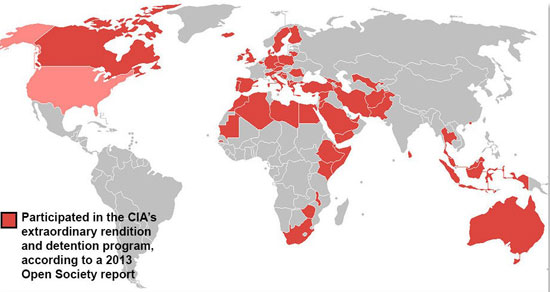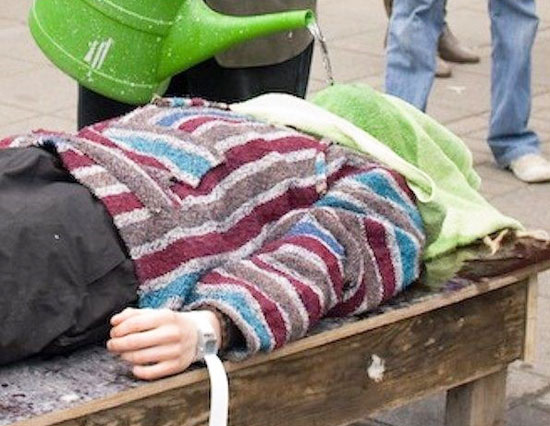The secret CIA torture program that has just come to light (1)

“CIA Extraordinary Rendition and Detention Program – countries involved in the Program”, according to the Open Society Foundation
A major aspect of the CIA’s detention and interrogation operations has been purposefully hidden from view, primarily due to secrecy guidelines that make it illegal for anyone “read into” the program to reveal even its very existence.
Recent declassified documents make clear that there was not one, but two CIA torture programs. These programs used different interrogation techniques, responded to different bureaucracies within the CIA, and had very different levels of oversight.
This article reveals for the first time a crucial untold aspect of the story behind the construction and development of the CIA’s torture programs, such as we can understand them today (December 2018).
We will try to retell the history of the CIA’s interrogation and detention programs with this new understanding of how they originated, were constructed, and how they operated. This revisionist history is open source document-based, and it’s worth noting that there is much disinformation and obscure history to clarify.
At the close of this article, we will look at some possible reasons for the separation of the two programs, and the meaning of all this for current investigators and concerned citizens.
It’s been sixteen years since Gul Rahman died of hypothermia, beaten and left half-naked and short shackled to a bare prison floor at the CIA-run Salt Pit “black site” prison in Afghanistan. It is not known what the CIA did to his corpse. His body was never turned over to his family.
According to a report by the Senate Select Committee on Intelligence, conditions at the Salt Pit were incredibly awful: “One senior interrogator told the CIA OIG that ‘literally, a detainee could go for days or weeks without anyone looking at him,’ and that his team found one detainee who, ‘as far as we could determine,’ had been chained to the wall in a standing position for 17 days.”
Yet in other documents, we are told that CIA detainees were under constant surveillance. When Abu Zubaydah was locked inside a confinement box by CIA torturers, there were cameras transmitting “grainy video” of him inside the box at all times. The amount of time spent in extended sleep deprivation was meticulously monitored for some detainees, but not others.
How could there be such wide divergence in CIA torture operations? What was going on?
A Secret Program on “Enhanced Interrogation”
In September 2006, the CIA’s “enhanced interrogation” and detention program essentially ended, when the remaining detainees held at CIA black sites around the world were sent to Guantanamo’s Camp 7. Its final demise can be traced to President Obama’s January 2009 withdrawal of the Bush-era Department of Justice memos which justified the use of waterboarding, extended sleep deprivation and other brutal interrogation techniques.
Four years have passed after a partial release of findings from a year’s long investigation into CIA interrogation practices by the Senate Select Committee on Intelligence (SSCI), yet only recently the full parameters of the CIA’s black site torture programs started to become clear.
A November 2018 ACLU document release of a 90 page memoir by the chief of the CIA’s Office of Medical Services (OMS) revealed there were two torture and interrogation programs run by the CIA.
Not one report on that release mentioned the revelation about the two programs, and none have commented on the importance given in this document to the actions of the CIA’s Office of Technical Services in relation to the torture program.
The OMS document is a devastating look into the mind and conscience of the CIA doctors and psychologists who helped conduct the CIA torture program. The memoir is remarkably self-serving, and yet also revealing, providing us the clearest view yet of the true parameters of the CIA’s use of torture during the Bush Administration.
Much that is perplexing about CIA torture operations – and one aspect of how the CIA is able to mask its covert actions around torture and detention – can be traced to the confusion surrounding the fact that there really were two interrogation programs all along.
One program was built around the testing of the “enhanced interrogation” techniques (EIT) derived from the military and the CIA’s own torture survival courses, which were meant to inoculate U.S. government personnel to the effects of torture at the hands of foreign captors. This EIT program was carefully planned and staffed by the CIA’s Office of Technical Services (OTS), and seems to have originated there as well.
Though they were not involved in its planning, the program also involved close monitoring by medical personnel staff and contractors in the CIA’s Office of Medical Services. OMS’s value to the program increased with time.
When, according to the head of OMS, the EIT-focused program’s existence was threatened in 2004-05, new Department of Justice memos approving the program “relied heavily and explicitly on OMS input, and underscored as never before an indispensable OMS role in legitimizing the program,” which included ongoing use of the waterboard.

The OTS-run program was known as the Rendition, Detention and Interrogation (RDI) Program, and operated as a special mission or special access program within the Special Mission Division (SMD) of the CIA’s Counterterrorism Center (CTC). In documents, it was also referred to at times as the Rendition Group, and the Rendition and Detention Group.
Then, there was the other CIA program, which largely had different personnel, was run totally out of CTC, and was not organized around the use of “enhanced interrogation.”
We will examine first the special mission portion of the CIA torture and detention program. Later in this article we will look more closely at the other CTC detention and torture program. Both programs utilized renditions, and had some kind of connection with foreign intelligence services.
The origins of the RDI program apparently lie within the CIA’s Office of Technical Services, a CIA division known for producing James Bond-like technical gadgets, forgery, secret writing, and assassination devices.
According to the SSCI report on CIA interrogation, it was OTS that in April 2002 cabled the CIA interrogation group holding Abu Zubaydah, considered the CIA’s first captured high-value terrorist, regarding its new “proposed interrogation strategy.”
Even earlier, OTS commissioned James Mitchell to write a monograph on Al Qaeda resistance to interrogation techniques.
From a larger perspective, it is worth noting that according to one declassified CIA document, in general, OTS receives its orders “through higher echelons (Office of the Director or Deputy Director for Operations).”
Roots in MKULTRA
OTS is also known for administering the CIA’s infamous MKULTRA program some decades ago. This fact did not go unremarked by the CIA’s OMS Chief.
According to his or her narrative, OTS contained a group of “operationally-oriented psychologists whose interests in interrogation extended back almost 50 years….”
While speculative, the 2002 incarnation of this group was possibly the Operational Assessments Division at OTS under CIA psychologist Kirk Hubbard. Hubbard has been linked a number of times to CIA contract psychologists James Mitchell and John Bruce Jessen, who have themselves been linked to construction of the “enhanced interrogation” techniques program, although they certainly weren’t alone in doing this.
The OMS Chief explained: “The antecedents of this unit had overseen much of the MKULTRA interrogation research in the 1950s and 1960s, published still-relevant classified papers on the merits of various interrogation techniques, contributed heavily to a 1963 KUBARK Counterintelligence Interrogation Manual and its derivative 1983 Human Resources Manual, assisted directly in early interrogations, and (with OMS) provided instruction in the Agency’s Risk of Capture training.”
The “Agency interest in interrogation” had begun “very early, and continued into the early Eighties, but was not a direct antecedent of the 2002 CTC approach, which came directly from Jessen and Mitchell’s SERE experience,” according to the OMS Chief’s account.
Still, “both SERE and initial Agency thinking, however, drew on the same early Agency and military-funded studies.”
But the Senate report clearly shows that old thinking and studies were not the only factors involved.
According to SSCI, the person chosen in late 2002 to be the “CIA’s chief of interrogations in the CIA’s Renditions Group, the officer in charge of CIA interrogations” had been elevated to his post despite having earlier been accused of “inappropriate use” of torture techniques drawn from the MKULTRA-inspired 1983 Human Resources Manual.
In 2002, Mitchell, Jessen and “other OTS psychologists,” in conjunction with “various [outside] psychologists, psychiatrists, academics, and the [Pentagon’s SERE office] Joint Personnel Recovery Agency,” provided data on the supposed safety and “effectiveness” of the proposed “enhanced interrogation” techniques to Department of Justice attorneys.
OTS would also provide the important interrogator and psychological staff sent to the black sites in the early days. One OTS early hire, even prior to 9/11, was former SERE psychologist and self-styled interrogation expert, James Mitchell.
SERE stands for Survival, Evasion, Resistance, Escape. The military’s SERE program under various names goes back to the late 1940s, born out of a need to train pilots involved in secret operations against the Soviet Union, which involved numerous covert flights over Soviet territory. The training included an experience in a mock torture and detention setting, purportedly to inoculate U.S. personnel against foreign imprisonment and torture.
Over time, the mock torture schools also became sites of experimental study. In addition, the CIA, it turns out, also ran its own separate version of SERE, though little is known about its operations.
Mitchell and Jessen, who previously worked for SERE, and other OTS personnel, apparently in consult with “outside experts,” would take the techniques used to make the SERE torture experience realistic and turn them on CIA prisoners in makeshift secret “black site” prisons situated around the world.
Read the second part of the article
yogaesoteric
January 28, 2019
